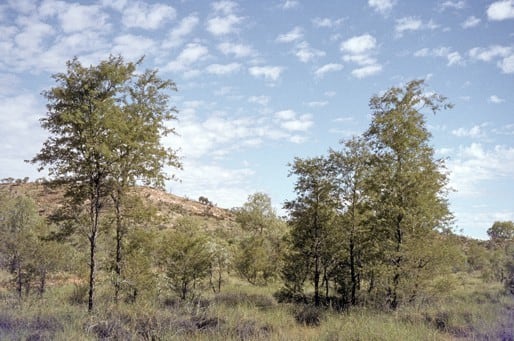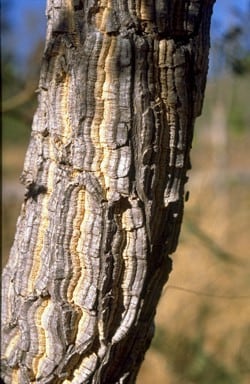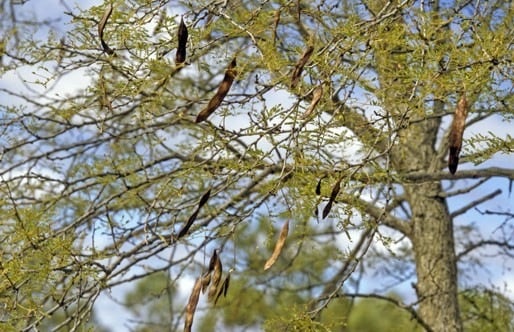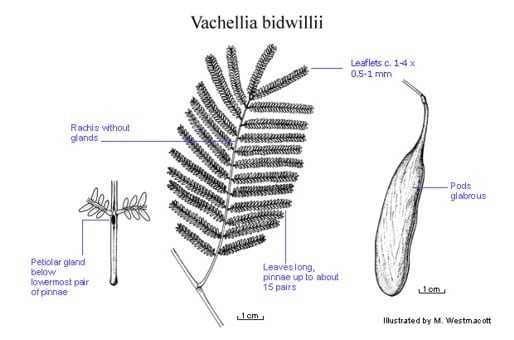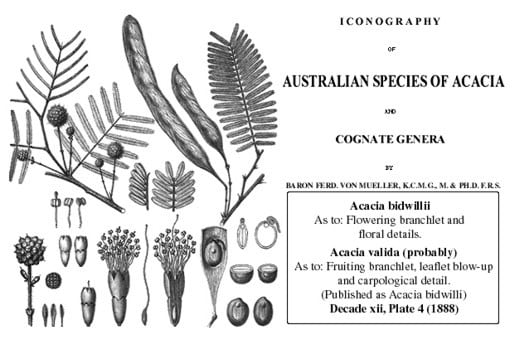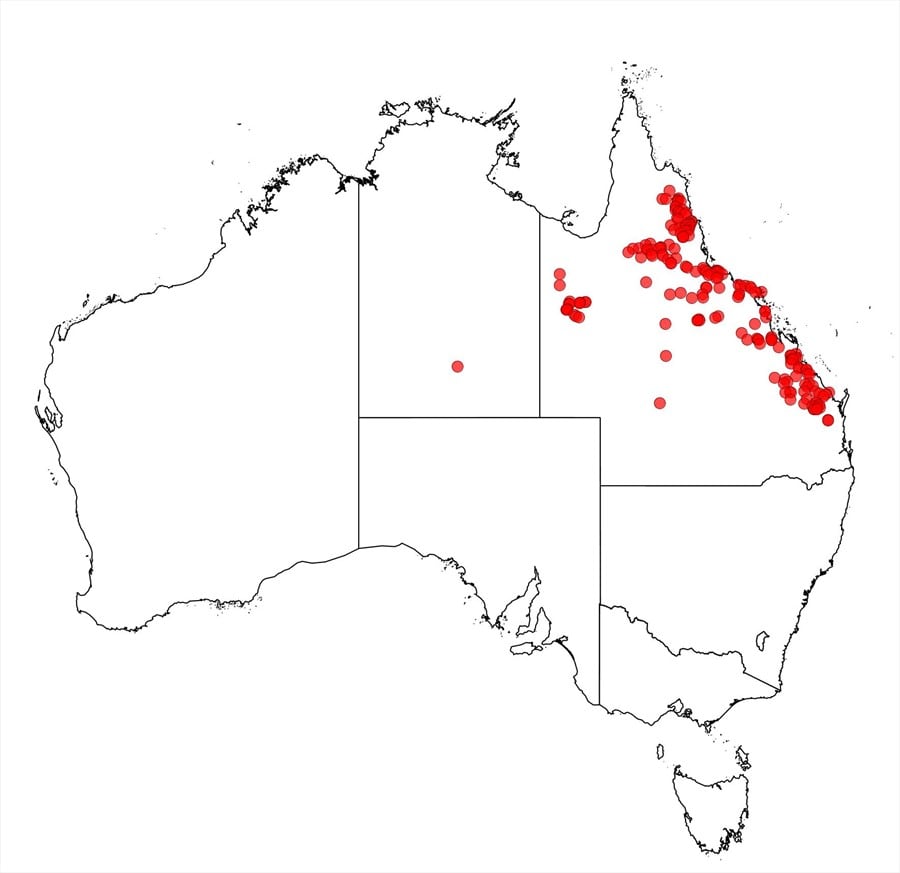Vachellia bidwillii (Benth.) Kodela
WATTLE
Acacias of Australia
Common Name
Corkwood Wattle, Dogwood
Family
Fabaceae
Distribution
Common in the Burnett and Port Curtis districts of Qld, but ranging as far N as Mt Carbine and with a western disjunction in the Mount Isa area.
Description
Shrub or tree 1.5–10 m high; branches sometimes pendulous. Bark corky, furrowed. Branchlets with scattered hairs to ±glabrous, sometimes pubescent. Stipular spines to 2 mm long, often inconspicuous, to 12 mm long on young plants. Leaves: petiole 0.4–1 cm long, pubescent above, mostly with a raised gland at base of lowest pair of pinnae; rachis 1.5–9 (–12.5) cm long, sparsely to moderately pubescent mainly above, eglandular; pinnae (3–) 4–15 (–25) pairs, 0.6–4.2 cm long; pinnules (6–) 15–25 (–30) pairs, oblong to narrowly oblong or elliptic to narrowly elliptic, mostly 1–3.7 mm long and 0.5–1.1 mm wide, obtuse, ±discolorous, ciliate usually only at base, with raised midnerve below. Inflorescences simple, 1 or 2 (–3) in axils, or sometimes on a raceme-like shoot that extends with growth; peduncles 15–40 mm long, with involucel of bracts 1/2–2/3 way above base; heads globular, 13–20-flowered, whitish to cream-coloured, sometimes pale yellow. Pods narrowly oblong to linear or narrowly elliptic, straight-sided or slightly constricted between some or all seeds, flat or slightly raised over seeds, 3–15 cm long, 8–16 (–19) mm wide, firmly crustaceous to coriaceous, longitudinally and often reticulately nerved, glabrous.
Phenology
Flowers mainly Nov. and Dec., sometimes Apr.–Oct., also sporadic; fruits (Dec.–) Apr.–Oct.
Habitat
Often occurs as a scattered understorey tree in grassy, open eucalypt woodland, as well as growing in open forest, Acacia woodland or sometimes shrubland, in clay, loam, sandy or stony soils, on plains or on valley floors, slopes and ridges in undulating to hilly country, and in skeletal soils on rocky slopes.
Specimens
Qld: 9 miles [14.5 km] SSE of Yarrowmere Stn, L.Adams 986 (AD, BRI, CANB, K, NSW, PERTH); 8.2 km by road NNW of Many Peaks towards Nagoorin, R.G.Coveny 6848 & P.Hind (BRI, CANB, K, MEL, MO, NSW, PERTH); 13.2 km c. S of Lakeland Downs toward Palmer R., R.G.Coveny 6977 & P.Hind (BRI, CANB, K, MEL, NSW); 5 miles [8 km] SE of Batheaston HS, M.Lazarides & R.Story 77 (BRI, CANB, MEL, NSW); Gympie–Goomeri road, 31 Oct. 1960, M.D.Tindale s.n. (BRI, CANB, MEL, NSW, PERTH).
Notes
Acacia bidwillii var. polytricha Domin, Biblioth. Bot. 89: 273, 1926 (T: Nord-Queensland: Savannenwalder bei Mungana, Feb. 1910, K.Domin; holo: PR n.v.), which is characterised by villous leaves, is treated by L.Pedley, Austrobaileya 6: 181 (2002) as a synonym of A. bidwillii where it is noted that its taxonomic status remains uncertain; it is treated as synonymous with V. bidwillii by P.G.Kodela & P.G.Wilson, Telopea 11: 234 (2006). Plants referable to this entity occur in low hilly country in the south-central part of Cape York Peninsula, Qld (e.g. J.R.Clarkson 3585, NSW, n.v.: BRI, DNA, ILL, K, MEL, MO, NSW, PERTH, PR, QRS; L.Pedley 1849, BRI n.v., NSW), and its geographic range abuts that of V. ditricha which occurs in country of lower relief, fide L.Pedley, pers. comm.
The undescribed species from the Douglas-Daly Rivers area, N.T. referred to by P.G.Kodela, Fl. Australia 11A: 202 (2001) is now described as V. douglasica.
Based on molecular and other data Acacia sens. lat. is now considered as comprising a number of segregate genera, see J.T.Miller & D.S.Seigler, Austral. Syst. Bot. 25: 217-224 (2012) for overview. Many taxa in the former Acacia subg. Acacia are now referable to the genus Vachellia, including the one presented here.
A variable species requiring further systematic study. Specimens not included in the above description include S.L.Everist & L.S.Smith 206 from ‘10 miles past Duchess on Mount Isa Road’ (BRI) which has pods to c. 21 cm long, and R.G.Coveny 6913 & P.Hind from ‘77 km by road NW of Marlborough towards St Lawrence’ (BRI, CANB, DNA, K, MEL, MO, NSW, PERTH) which has rachises to 14.5 cm long with up to c. 40 pairs of pinnae. Acacia leptoclada var. polyphylla has well developed stipular spines to 6 mm long and leaves with smaller pinnules than usual, which are probably characteristics of juvenile plants, fide L.Pedley, pers. comm.
In J.W.Turnbull (ed.), Multipurpose Austral. Trees & Shrubs 112 (1986) there is an account of V. bidwillii (as Acacia bidwillii) before it was split into several species, while a more recent brief account is given in J.C.Doran & J.W.Turnbull (eds), Austral. Trees & Shrubs: species for land rehabilitation & farm planting in the tropics 346 (1997). The roots of young trees were roasted and eaten by Aborigines, and young plants may be browsed by cattle, fide E.Anderson, Pl. Central Queensland 22 (1993).
FOA Reference
Data derived from Flora of Australia Volumes 11A (2001), 11B (2001) and 12 (1998), products of ABRS, ©Commonwealth of Australia
Author
P.G.Kodela
This identification key and fact sheets are available as a mobile application:
URL: https://apps.lucidcentral.org/wattle/
© Copyright 2018. All rights reserved.

